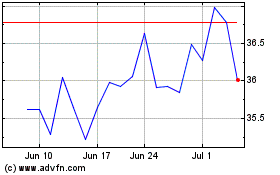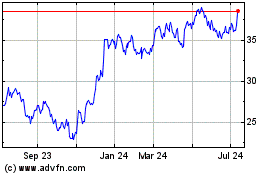Kevin Kabat Announces Retirement
The Fifth Third Bancorp board of directors today announced that
Greg D. Carmichael, current president and chief operating officer,
will become president and chief executive officer effective
November 1, 2015. Carmichael was also elected to the board,
effective immediately.
Carmichael will succeed Kevin T. Kabat, who has informed the
board of his intention to retire. Kabat has served as CEO since
April, 2007, and he will remain executive vice chairman of the
board until his retirement in April 2016. His career included 33
years of combined service at Fifth Third and a predecessor.
Board chair James P. Hackett said that the succession provides
continuity of leadership and leverages the extensive experience of
Carmichael in leading all operating units of the Bank. Hackett
said, “Greg is the ideal choice, and the Bank is well-positioned
for future growth, with a diverse and dynamic consumer business, an
expanding wealth management business, and a strong commercial
business with expanding scale and scope.”
Hackett also said, “We thank Kevin for all he has done for the
Fifth Third organization during his tenure, particularly in
navigating the financial crisis. During Kevin’s tenure as CEO,
Fifth Third has established strong forward momentum with a strong
balance sheet, solid credit quality, and excellent growth
prospects.”
“Greg will be a terrific CEO,” said Kabat. “As the president and
chief operating officer, he has demonstrated an unwavering focus on
our customers, employees, communities, and shareholders. Greg will
continue to bring his passion to leading the Fifth Third
organization during an era of continued change in how we deliver
value to all of our constituents.”
“I am honored to lead such a great company that is well
positioned for growth, with dedicated employees who are committed
to meeting our customers’ needs every day,” said Carmichael. “I
look forward to leading the Fifth Third team at a time of great
opportunity, as we address shifting customer preferences and
deliver new solutions that meet the needs of our customers.”
Carmichael joined Fifth Third in 2003, leading Information
Technology. He became chief operating officer in 2006, and by 2009
his responsibilities had expanded to include leading the Retail
Bank, Investment Advisors, Business Banking, and all affiliate
banks and markets. Carmichael was named president in 2012, when the
national Commercial line of business was added to his role.
Prior to joining Fifth Third, Carmichael served as chief
information officer for Emerson Electric and in leadership roles in
information technology at General Electric for more than a
decade.
Kabat will transition leadership responsibilities over the
coming months. In addition to his service on the Fifth Third board,
he will continue to serve on the board of UNUM, as well as the
board of NISource, a board appointment that was just announced.
Fifth Third Bancorp (NASDAQ: FITB) is a diversified financial
services company headquartered in Cincinnati, Ohio. As of March 31,
2015, the Company had $140 billion in assets and operated 15
affiliates with 1,303 full-service Banking Centers, including 101
Bank Mart® locations, most open seven days a week, inside select
grocery stores and 2,637 ATMs in Ohio, Kentucky, Indiana, Michigan,
Illinois, Florida, Tennessee, West Virginia, Pennsylvania,
Missouri, Georgia and North Carolina. Fifth Third operates four
main businesses: Commercial Banking, Branch Banking, Consumer
Lending, and Investment Advisors. Fifth Third also has a 22.8%
interest in Vantiv Holding, LLC. Fifth Third is among the largest
money managers in the Midwest and, as of March 31, 2015, had $308
billion in assets under care, of which it managed $27 billion for
individuals, corporations and not-for-profit organizations.
Investor information and press releases can be viewed at
www.53.com. Fifth Third's common stock is traded on the NASDAQ®
Global Select Market under the symbol "FITB."
FORWARD-LOOKING STATEMENTS
This release contains statements that we believe are
“forward-looking statements” within the meaning of Section 27A of
the Securities Act of 1933, as amended, and Rule 175 promulgated
thereunder, and Section 21E of the Securities Exchange Act of 1934,
as amended, and Rule 3b-6 promulgated thereunder. These statements
relate to our financial condition, results of operations, plans,
objectives, future performance or business. They usually can be
identified by the use of forward-looking language such as “will
likely result,” “may,” “are expected to,” “anticipates,”
“potential,” “estimate,” “forecast,” “projected,” “intends to,” or
may include other similar words or phrases such as “believes,”
“plans,” “trend,” “objective,” “continue,” “remain,” or similar
expressions, or future or conditional verbs such as “will,”
“would,” “should,” “could,” “might,” “can,” or similar verbs. You
should not place undue reliance on these statements, as they are
subject to risks and uncertainties, including but not limited to
the risk factors set forth in our most recent Annual Report on Form
10-K as updated from time to time by our Quarterly Reports on Form
10-Q. When considering these forward-looking statements, you should
keep in mind these risks and uncertainties, as well as any
cautionary statements we may make. Moreover, you should treat these
statements as speaking only as of the date they are made and based
only on information then actually known to us.
There are a number of important factors that could cause future
results to differ materially from historical performance and these
forward-looking statements. Factors that might cause such a
difference include, but are not limited to: (1) general economic
conditions and weakening in the economy, specifically the real
estate market, either nationally or in the states in which Fifth
Third, one or more acquired entities and/or the combined company do
business, are less favorable than expected; (2) deteriorating
credit quality; (3) political developments, wars or other
hostilities may disrupt or increase volatility in securities
markets or other economic conditions; (4) changes in the interest
rate environment reduce interest margins; (5) prepayment speeds,
loan origination and sale volumes, charge-offs and loan loss
provisions; (6) Fifth Third’s ability to maintain required capital
levels and adequate sources of funding and liquidity; (7)
maintaining capital requirements and adequate sources of funding
and liquidity may limit Fifth Third’s operations and potential
growth; (8) changes and trends in capital markets; (9) problems
encountered by larger or similar financial institutions may
adversely affect the banking industry and/or Fifth Third; (10)
competitive pressures among depository institutions increase
significantly; (11) effects of critical accounting policies and
judgments; (12) changes in accounting policies or procedures as may
be required by the Financial Accounting Standards Board (FASB) or
other regulatory agencies; (13) legislative or regulatory changes
or actions, or significant litigation, adversely affect Fifth
Third, one or more acquired entities and/or the combined company or
the businesses in which Fifth Third, one or more acquired entities
and/or the combined company are engaged, including the Dodd-Frank
Wall Street Reform and Consumer Protection Act; (14) ability to
maintain favorable ratings from rating agencies; (15) fluctuation
of Fifth Third’s stock price; (16) ability to attract and retain
key personnel; (17) ability to receive dividends from its
subsidiaries; (18) potentially dilutive effect of future
acquisitions on current shareholders’ ownership of Fifth Third;
(19) effects of accounting or financial results of one or more
acquired entities; (20) difficulties from Fifth Third’s investment
in, relationship with, and nature of the operations of Vantiv, LLC;
(21) loss of income from any sale or potential sale of businesses
that could have an adverse effect on Fifth Third’s earnings and
future growth; (22) difficulties in separating the operations of
any branches or other assets divested; (23) inability to achieve
expected benefits from branch consolidations and planned sales
within desired timeframes, if at all; (24) ability to secure
confidential information and deliver products and services through
the use of computer systems and telecommunications networks; and
(25) the impact of reputational risk created by these developments
on such matters as business generation and retention, funding and
liquidity.
You should refer to our periodic and current reports filed with
the Securities and Exchange Commission, or “SEC,” for further
information on other factors, which could cause actual results to
be significantly different from those expressed or implied by these
forward-looking statements.
View source
version on businesswire.com: http://www.businesswire.com/news/home/20150708005658/en/
Fifth Third BancorpJim Eglseder (Investors), 513-534-8424Larry
Magnesen (Media), 513-534-8055
Fifth Third Bancorp (NASDAQ:FITB)
Historical Stock Chart
From Mar 2024 to Apr 2024

Fifth Third Bancorp (NASDAQ:FITB)
Historical Stock Chart
From Apr 2023 to Apr 2024
